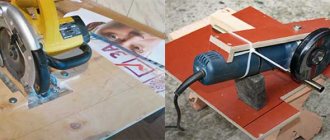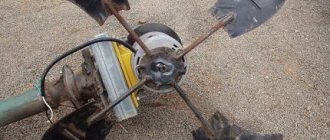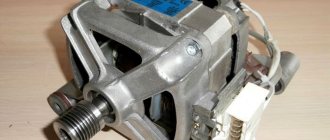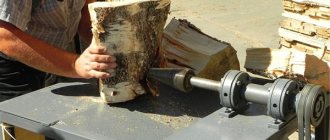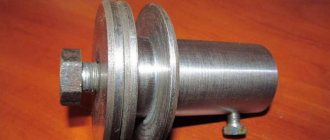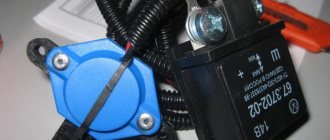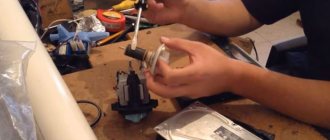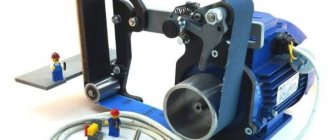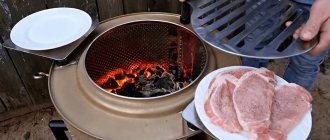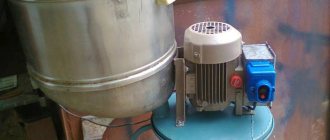After a certain period of operation, washing machines lose their ability to work normally and are replaced by more modern models. The basis of each such washing machine is an electric motor, which, after disassembling the device, can be used. The power rating of the dismantled motor is at least 220 V, the rotation speed reaches 11,000 rpm, which is very suitable for using such motors on the farm. Today we’ll try to figure out how to connect the motor from an old washing machine so that we can use its potential.
Connecting a motor with a starting winding
First, using a tester, we find the corresponding output pairs. By ringing the wires, we identify the pairs, after which we find out which of them is the starting one and which is the working one. A higher resistance value corresponds to the starting pair creating the initial torque.
On some washing machine engines, contactors can be replaced with small capacitors, which is very convenient for operating washing machines. And when the motor is started without load, this type of motor is able to start working independently, without a capacitor and initial power supply from the start winding.
When the engine heats up, the reasons are as follows:
- bearings are worn out,
- the gap decreased, and the rotor and stator began to come into contact,
- high capacitor capacity.
To make sure the engine is working properly, you need to let it run for one minute and check the heating. In such a short time, the heat will not have time to disperse through the parts, and it is possible to accurately track the point of strong heating - a bearing, stator or something else. This is then checked three times after five minutes of operation.
How to connect an inverter type motor
In most articles on the topic of making something with your own hands, it is recommended not to buy the necessary components, but to use components from household appliances that have served their purpose. The decision is quite rational. An electric motor from a used washing machine is often mentioned, which due to its characteristics is suitable for assembling many technical devices. It's easy to dismantle. But problems often arise with connecting the electric motor from the washing machine to the 220/50 network. Let's figure out how to do this correctly.
There are quite a few brands and modifications (series) of washing machines. Consequently, the circuits for connecting electric motors to a 220 V network are different, and therefore the number of wires coming from them is different.
Brushed motors
These are motors that do not have a starting winding. They can operate on both direct and alternating current and do not need to be connected via a capacitor. Motors of this type have from five to eight terminals, but such a number will not be needed for further operation of the unit. Therefore, you will have to identify and disconnect the contacts going to the tachometer, thermal protection, etc.
Selecting a capacitor for a single-phase motor
In the vast majority of cases, capacitors for asynchronous motors are used to connect to a “standard” voltage (220 V), taking into account the inclusion of the device in a single-phase network. However, the process of using them is much more complicated. Let's figure out why.
Three-phase motors operate on the basis of a constructive connection, while single-phase motors have to achieve biased torque. This is ensured by an additional layer of rotor winding for starting. The phase is shifted by a capacitor.
Expert advice
When deciding to connect the motor from an old washing machine to use it for new purposes, you need to know two important conditions:
- the capacitor is not used when connecting,
- there is no need for a start winding.
To make it more convenient to understand the transfer case wiring, you need to know its color codes:
- a pair of white wires comes from the tachogenerator, and will be used in the future,
- wiring in red and brown shades leads to the rotor and stator winding,
- graphite brushes are connected with gray and green wires.
Please note that the color of the wires may vary in different models of washing machines, but the connection principle remains the same.
How to adjust rotation
There are many ways to control speed:
- laboratory autotransformer;
- adjustment board for household appliances;
- screwdriver buttons, grinders;
- lighting regulators (switches, toggle switches).
The adjustment scheme is simple, you can do it yourself.
This is a satisfactory option for a pump or fan. For more powerful mechanisms (for example, machine tools), a different regulator circuit will be needed.
Read also: How to determine the brand of a 380V USSR welding machine
The essence of the question is how to reduce speed without losing performance? The connection is made through a tachogenerator, which transmits the number of turns to the speed controller microcircuit, which coordinates the cycle using a thyristor.
Such a board allows you to either increase or decrease the speed, but requires constant, intensive cooling due to overheating. A detailed video about how the speed and power of the stroke are regulated by connecting to the microcircuit can be viewed here:
Now you know what speed different types of engines make and how to set up this process in your home workshop. Good luck!
Washing machines, like any household appliance, tend to break down. And it’s good if the breakdown can be corrected at low financial cost. But alas, there are times when there is no point in repairing a washing machine, since it is easier and cheaper to buy a new unit. But what to do with the old one? Moreover, if its engine is in excellent condition and continues to work properly.
Speed control relay
Connection diagram
To proceed further, you should study the electrical connection diagram, which does not cause any particular difficulties in operation even for an ordinary user.
To begin with, take the wires that supply the stator and rotor of the washing machine. The stator winding is connected to the rotor brush. For this purpose, an insulated jumper is installed. The remaining two wires are connected to the home network at 220 V.
Please note that when the motor is connected to the electrical network, its rotation begins immediately. To avoid injury, the motor is first rigidly fixed to the surface - this guarantees a safe check of its functionality after connection
To change the direction of rotation, you just need to move the jumper to other terminals. To make it convenient to start and stop the motor, the necessary buttons are added to the circuit.
Theory of operation of a 220 V electric motor
Asynchronous motors for single-phase networks are mainly motors with two-phase windings and an auxiliary phase taken from a capacitor. Such motors are used in household appliances. A similar motor is used, in particular, to drive a washing machine. In addition to two-phase winding motors, three-phase winding motors are sometimes used in some other household appliances.
During direct starting, the motor can receive a current from the network that significantly exceeds its rated value. This current is called the motor starting current, and its value varies in the region Ir = 5-7In .
One way to reduce the inrush current is to use a star-delta switch. A motor designed to operate the stator in a triangular connection at a given mains voltage is connected to the star system at the time of start-up:
Due to the reduced voltage supplied to the stator winding phase and the change in connections from delta to star, the current taken from the network will be reduced by three times compared to the starting current in a delta circuit. However, when connected to a star, the motor has three times less starting torque, which makes it impossible to use this method during heavy starting (with a heavy load).
Speed regulator
The motor from the old machine for washing clothes differs in a higher number of revolutions per minute, for this reason you will have to connect a regulator that ensures operation at different speed modes and protects the motor from overheating. For these purposes, a simple light intensity relay is used, but it will have to be slightly modified:
- The triac complete with radiator is removed from the washing machine. This semiconductor in the electronic control circuit is designed to turn off the unit,
- the element is soldered into a relay microcircuit instead of a low-power part. It is better to entrust such work to a master.
The device of the commutator electric motor of an automatic washing machine
The appearance of motors of different models may differ, but the design and operating principle are almost identical. The device consists of:
- housings;
- starter;
- starter coils (shoes) with two or three terminals;
- anchors;
- pulley;
- two brushes;
- collector;
- tachometer (with two or three wires);
- terminal block.
To connect the motor, you need to know the outputs of the armature, starter and tachometer windings. A tester will help you avoid getting tangled in wires.
Easy motor connection
Set the tester to the mode of least resistance and call the windings of the tachometer, coils and armature. Make connections through terminals that communicate with each other. A correctly connected device picks up speed smoothly, does not crackle or spark. You can check how many revolutions the motor makes using a speed sensor.
A visual step-by-step implementation can be seen in this video:
Motor application options
After disassembling the old washing machine, the electric motor can be installed on one of the devices.
Grinder
Sometimes a difficulty arises here - the hole in the stone differs from the size of the shaft of the electric motor. You will have to machine an additional part that will act as a transition element. For fixation, a nut with a thread direction that takes into account the direction of rotation of the motor is used. Otherwise, the direction of the torque is changed by switching the wiring to opposite contacts.
Having connected the winding to the mains, the starting pair is connected to the coil. The second end of the wiring is briefly applied to the winding terminal to check the direction of movement of the motor.
To design a sharpening machine, it is best to use a motor that can withstand voltage in the range of 150 - 200 V. In this case, a rotation speed of the stone of 1,000 revolutions is enough to prevent it from breaking.
Vibrating table
An excellent use for a motor from an old machine if you are making paving slabs.
Structurally, such a table does not cause any difficulties. To make it, a flat surface in the form of a plate, fastened to the base with movable elements, is sufficient. The commutator motor will provide the necessary vibration.
Concrete mixer
The motor can be used in this way as well. Such a unit will not provide industrial volumes, but it will significantly facilitate household work.
It is noteworthy that along with the motor you will have to use the washing machine tank. It is best if the container is of the activator type - instead of the standard element, a pair of steel blades is installed, externally resembling the letter “P”. They are positioned in such a way as to create a right angle. The tank drain hole is securely closed.
The power of the motor of the old car selected for connection is determined by the volume of work to be done. To prepare concrete in small quantities, it is sufficient to use a single-phase motor.
We will also have to resolve the issue with the belt drive installed in the car. It is best to replace it with a gearbox that can reduce engine speed.
Hand mixer
Using this device, you can mix mortar for plastering and adhesive for laying tiles.
Lawnmower
The engine from a washing machine is an excellent solution in terms of power and size to make a wheeled lawn mower. You will need a wheeled platform in the center of which the engine is installed. From it a direct connection is made to the knives located below. The cutting height is adjusted by the fit of the wheels in relation to the base of the mower.
In addition, from a used washing machine you can also construct:
- juicer,
- smokehouse,
- grill,
- grain crusher,
- feather removal machine,
- wind generator,
- emery,
- grinder,
- wax refiner
- and much more.
Capacitor for electric motor
For small motors (<1 kW), the value of the starting capacitor can be determined from the relationship:
C [uF] = (1800 x Pn) / U2
where Pn [W] – rated motor power, U [V] – supply voltage.
This formula is also suitable for calculating the starting capacitor value for single-phase start-phase motors.
For larger motors (>1kW) a capacitance of around 70uF/1kW is suggested. It is necessary to use starting capacitors with operating voltages of 400..630 V AC.
You can omit the calculations and simply connect a standard motor from the washing machine to 1 phase 220 V through a 7 microfarad capacitor connected between the required terminals. Connect the first power wire to the middle, and the second, depending on the direction of rotation, to one of the capacitor wires. The power drop will be 30% - this is in theory.
The issue of choosing a capacitor is easily resolved. Here are examples of capacitance values for different engine powers.
Pn [W] 90 120 180 250 370 550 750 1100 S [µF] 4 5 6 8 12 16 20 30
Useful: Electrical installation of 220V equipment for apartments and houses
The rotation power in the washing machine is the same in both directions. These are motors with a typical connection for a single-phase motor. The main winding is connected directly to 220 V and a phase winding is connected in parallel with it along with a series-connected capacitor. If you reverse the phase winding wires, the motor will rotate in the other direction, but the power will be slightly less. This circuit works during the spin cycle. The same for slow and fast rotations - the capacitance switches inside the washer from 7 µF to 16 µF. Read more about the capacitor here
How to increase engine speed and reduce it?
The motor speed controller can be ordered on the well-known Aliexpress website. It is worth understanding that cheap products from China do not always correspond to the declared quality, so be sure to diagnose the device. Remove the internal “stuffing” from the case and carefully inspect the triac. If you're lucky, it will have a small heatsink that barely does its job of preventing overheating. In the worst case, it won’t be there at all, then you’ll have to buy the part separately.
On an “imperfect” radiator you will have to cut an M3 thread. Then apply a little thermal paste to the surface of the triac and fix the improved heat exchanger in its original place. Then reassemble the regulator.
Behind the device there is a strip with several connectors and terminals. All exits are signed. It is necessary to find the neutral contact, phase and ground, and the corresponding cables are connected to them.
The purpose of each output and the corresponding wire color should be described on the top panel of the speed controller housing.
Typically, the yellow output wire is ground, a pair of blue ones are pins for connecting a tachometer, and bright red is a phase. The snow-white and green contacts are interchangeable, which is regulated by a jumper. You can determine the resistance of the terminals by testing them with a multimeter.
Once you understand the device, connect it to the engine. Check that the wires are connected to the correct terminals. When finished, apply 220-volt voltage to the electric motor speed controller. Now it’s easy to switch the speed and rotation modes of the engine with your own hands.
There is also a special hole on the walls of the controller. It is designed to adjust the operating modes of the electric motor with a variable resistor. You can set the step for changing the motor speed. Then, when the chain starts, the rotation of the rotor will not be “jerky”, but will start smoothly, almost from scratch.
Interesting:
- Balancing the washing machine drum
- Vibrating plate from a washing machine motor
- Is it worth doing repairs to electronic modules yourself?
- Repairing and checking the washing machine motor...
- Technical characteristics of the washing machine motor
- Dishwasher malfunctions
Reader comments
- Share your opinion - leave a comment
